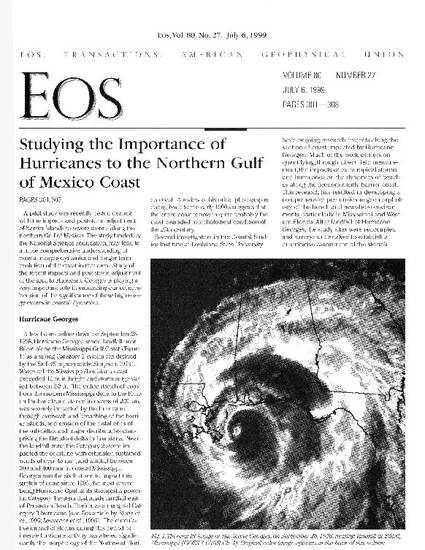
A pilot study was recently begun dealing with the impacts and post-storm adjustment of barrier islands to severe storms along the northern Gulf of Mexico. The study, funded by the National Science Foundation, may lead to a more comprehensive understanding of coastal morphodynamics and longer term evolution of the coast in that area. Study of the recent impacts and post-storm adjustment of the area to Hurricane Georges is playing a very important role in enhancing our comprehension of the significance of these high-energy events in coastal dynamics.
A few hours before dawn on September 28, 1998, Hurricane Georges made landfall near Biloxi along the Mississippi Gulf Coast (Figure 1) as a strong Category 2 system (as defined by the Saffir/Simpson scale: Simpson, 1974). Waves off the Mississippi/Louisiana coast exceeded 10 m in height and storm surge varied between 2–3 m. The entire stretch of coast from the modern Mississippi delta to the Florida Panhandle, a distance in excess of 200 km, was severely impacted by the hurricane through overwash and breaching of the barrier islands, and erosion of the distal ends of the sub-deltas and major distributaries comprising the Birdsfoot delta in Louisiana. Near the landfall zone, the Category 2 storm impacted the coastline with estimated sustained winds of over 45 ms−1, and rainfall between 300 and 400 mm in coastal Mississippi. Georges was the sixth storm to impact this stretch of coast since 1995, the most severe being Hurricane Opal, at its strongest a powerful Category 4 system that made landfall east of Pensacola Beach, Florida, as a marginal Category 3 hurricane [see Eos article by Stone et al., 1996; Lawrence et al., 1998]. The cumulative impact of storms during this period of intense hurricane activity has altered significantly the morphology of the Northwest Florida coast. A review of historical photographs dating back to the early 1900's suggests that the entire coast is now in quite probably the most degraded morphological condition of the 20th century.
Eos, Transactions American Geophysical Union, v. 80, issue 27, p. 301-305
©1999. American Geophysical Union. All Rights Reserved.
Available at: http://works.bepress.com/pingwang/121/